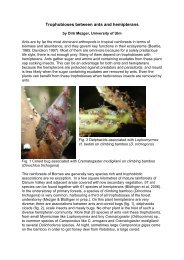Identification guide to the ant genera of Borneo - AntBase.net
Identification guide to the ant genera of Borneo - AntBase.net
Identification guide to the ant genera of Borneo - AntBase.net
Create successful ePaper yourself
Turn your PDF publications into a flip-book with our unique Google optimized e-Paper software.
Y. HASHIMOTO<br />
Metapleural grand (MG)<br />
The metapleural grand is an exocrine gland whose<br />
orifice is usually situated in <strong>the</strong> posteroventral<br />
corner <strong>of</strong> <strong>the</strong> side <strong>of</strong> <strong>the</strong> alitrunk, above <strong>the</strong> level <strong>of</strong><br />
<strong>the</strong> metacoxa and below <strong>the</strong> level <strong>of</strong> <strong>the</strong> propodeal<br />
spiracle.<br />
Mouthparts<br />
The appendages <strong>of</strong> <strong>the</strong> head used for feeding,<br />
including <strong>the</strong> labrum, hypopharynx, mandibles,<br />
maxillae, and labium.<br />
Occipital carina (OC)<br />
A ridge on <strong>the</strong> posterior surface <strong>of</strong> <strong>the</strong> head that<br />
separates <strong>the</strong> occiput from <strong>the</strong> vertex and gena.<br />
Maxillary palps (MP): The segmented sensory palps<br />
<strong>of</strong> <strong>the</strong> maxillae. Each palp may have at most 6<br />
segments but <strong>the</strong>se are variously reduced in number<br />
in different <strong>ant</strong> groups.<br />
Labial palps (LP): The segmented sensory palps <strong>of</strong><br />
<strong>the</strong> abium. Each palp may have at most 4 segments<br />
but <strong>the</strong>se are variously reduced in number in<br />
different <strong>ant</strong> groups. A way <strong>of</strong> indicating <strong>the</strong> number<br />
<strong>of</strong> segment in <strong>the</strong> maxillary and labial palps is<br />
termed as Palp Formula (PF). The number <strong>of</strong><br />
maxillary palp segments is given first, <strong>the</strong> number<br />
<strong>of</strong> labial palp segments second.<br />
Petiole (PT)<br />
The second abdominal segment (see Abdomen). The<br />
petiole takes <strong>the</strong> form <strong>of</strong> a node (nodiform) or <strong>of</strong> a<br />
scale (squamiform), but in some taxa it may be<br />
represented by only a narrow, subcylindrical<br />
segment.<br />
Labrum (LB): Mouthpart sclerite that hinges on <strong>the</strong><br />
<strong>ant</strong>erior margin <strong>of</strong> <strong>the</strong> clypeus and usually folds<br />
back and down over <strong>the</strong> apices <strong>of</strong> <strong>the</strong> maxillae and<br />
labium when <strong>the</strong> mouthparts are not in use.<br />
Peduncle (PD): The relatively narrow <strong>ant</strong>erior section<br />
<strong>of</strong> <strong>the</strong> petiole. when <strong>the</strong> peduncle is present, <strong>the</strong><br />
petiole is termed pedunculate. When <strong>the</strong> peduncle<br />
is absent, so that <strong>the</strong> node or scale <strong>of</strong> <strong>the</strong> petiole<br />
immediately follows <strong>the</strong> articulation with<br />
propodeum, <strong>the</strong> petiole is termed sessile.<br />
142 Part 3 - COLLECTING, HANDLING, IDENTIFICATION AND STORAGE FOR SELECTED GROUPS




